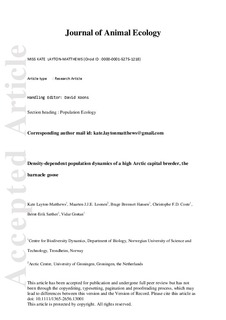| dc.contributor.author | Layton-Matthews, Kate | |
| dc.contributor.author | Loonen, M. J. J. E | |
| dc.contributor.author | Hansen, Brage Bremset | |
| dc.contributor.author | Coste, Christophe Francois Daniel | |
| dc.contributor.author | Sæther, Bernt-Erik | |
| dc.contributor.author | Grøtan, Vidar | |
| dc.date.accessioned | 2019-05-16T08:43:28Z | |
| dc.date.available | 2019-05-16T08:43:28Z | |
| dc.date.created | 2019-04-30T14:09:16Z | |
| dc.date.issued | 2019 | |
| dc.identifier.issn | 0021-8790 | |
| dc.identifier.uri | http://hdl.handle.net/11250/2597791 | |
| dc.description.abstract | Density regulation of the population growth rate occurs through negative feedbacks on underlying vital rates, in response to increasing population size. Here, we examine in a capital breeder how vital rates of different life history stages, their elasticities, and population growth rates are affected by changes in population size.
We developed an integrated population model for a local population of Svalbard barnacle geese, Branta leucopsis, using counts, reproductive data and individual‐based mark‐recapture data (1990‐2017) to model age class‐specific survival, reproduction and number of individuals. Based on these estimates, we quantified the changes in demographic structure and the effect of population size on age class‐specific vital rates and elasticities, as well as the population growth rate.
Local density regulation at the breeding grounds acted to reduce population growth through negative effects on reproduction; however, population size could not explain substantial variation in survival rates, although there was some support for density‐dependent first year survival.
With the use of prospective perturbation analysis of the density‐dependent projection matrix, we show that the elasticities to different vital rates changed as population size increased. As population size approached carrying capacity, the influence of reproductive rates and early life‐survival on the population growth rate were reduced, whereas the influence of adult survival increased. A retrospective perturbation analysis revealed that density dependence resulted in a positive contribution of reproductive rates, and a negative contribution of the numbers of individuals in the adult age class, to the realised population growth rate.
The patterns of density dependence in this population of barnacle geese were different from those recorded in income breeding birds, where density regulation mainly occurs through an effect on early life survival. This indicates that the population dynamics of capital breeders, such as the barnacle goose, are likely to be more reproduction‐driven than is the case for income breeders. | nb_NO |
| dc.language.iso | eng | nb_NO |
| dc.publisher | Wiley for British Ecological Society | nb_NO |
| dc.title | Density‐dependent population dynamics of a high Arctic capital breeder, the barnacle goose | nb_NO |
| dc.type | Journal article | nb_NO |
| dc.type | Peer reviewed | nb_NO |
| dc.description.version | acceptedVersion | nb_NO |
| dc.source.journal | Journal of Animal Ecology | nb_NO |
| dc.identifier.doi | 10.1111/1365-2656.13001 | |
| dc.identifier.cristin | 1694791 | |
| dc.relation.project | Norges forskningsråd: 273451 | nb_NO |
| dc.relation.project | Norges forskningsråd: 276080 | nb_NO |
| dc.relation.project | Norges forskningsråd: 244647 | nb_NO |
| dc.relation.project | Norges forskningsråd: 223257 | nb_NO |
| dc.description.localcode | Locked until 29.4.2020 due to copyright restrictions. This is the peer reviewed version of an article, which has been published in final form at https://doi.org/10.1111/1365-2656.13001. This article may be used for non-commercial purposes in accordance with Wiley Terms and Conditions for Self-Archiving. | nb_NO |
| cristin.unitcode | 194,66,10,0 | |
| cristin.unitname | Institutt for biologi | |
| cristin.ispublished | true | |
| cristin.fulltext | postprint | |
| cristin.qualitycode | 2 | |
